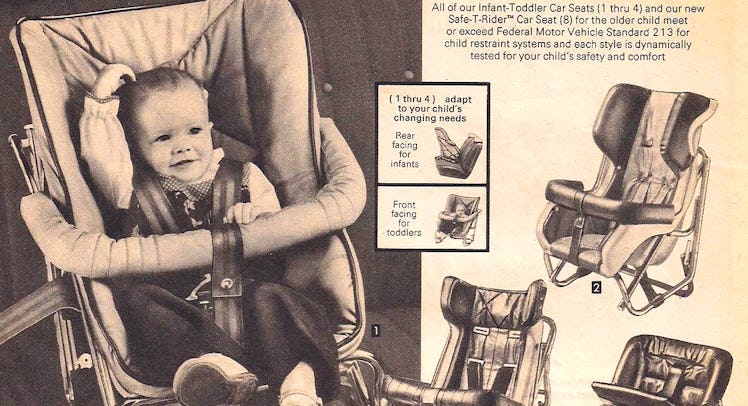The Surprisingly Brief (And Appallingly Lax) History Of Car-Seat Safety
Safe car seats are a modern phenomenon. Here's how the industry went from untested novelties to the highest standards in safety.

Fighting your squirmy kid into a car seat can be one of the banes of parenting. But unlike some of your toddler’s other tantrums, this one has dire implications. Your child will survive a fashion faux pas. Not so with an improperly secured car seat.
Yet car seats are something of a modern phenomenon. “A lot of people in the past had this fatalistic idea about car travel,” says Stephanie Tombrello, the executive director of SafetyBeltSafe USA. “Some people would die, some people would get hurt, they thought it was just chance.” In fact, the earliest car seat models weren’t even made to prevent injuries. In the 1930s and 1940s, the Bunny Bear Company produced booster seats so that children could look out the car window.
Through the early 1960s one could buy devices like “The Tiny World Sit-N-Stand Carseat,” which allowed kids to stand up and stretch their legs mid-voyage. Other car seats consisted of plastic seats, with hooks to loosely anchor them, and some featured a steering wheel a kid could spin just like a driving parent. Suffice to say none of these car seats were safe — nor were they created with safety in mind.
It wasn’t until 1962 that the British inventor Jean Ames built a rear-facing car seat designed to keep kids safe in the event of a crash. Leonard Rivkin, an American inventor, developed a forward-facing model shortly thereafter that was basically a metal frame surrounded by a strap. Neither were very safe by today’s standards.
In the States, Ford was the first manufacturer to offer a car seat. Called the “Astro-Guard,” the $30 bucket seat kept kids stationary via a harness anchored at four points. But it offered little protection for children’s vulnerable heads and necks. Ford tweaked its design and by 1965 became the first manufacturer to offer a relatively safe car seat, known as the Tot-Guard. This basic seat featured a plastic shell that provided support and restraint to the upper body. General Motors’ rear-facing infant “Love Seats” followed in 1969. These featured different size options for infants and children and were made from polypropylene and padded with urethane foam.
Both GM and Ford’s offerings passed the federal government’s first crash test, performed in 1971. But when Consumer Reports followed with their first test of car seats in 1972, both failed. There were other one-offs, like the short-lived and very troubling “Steel Travel Platform,” sold in 1969, which was just a vinyl pad upon which kids could freely play in the back of a moving car.
Car seats were still something of a novelty, until a grassroots lobbying effort pressured politicians in Tennessee to mandate the use of car seats in 1978. “Two things had to change: laws and social norming,” says Tombrello. Within seven years, both were in place, and all 50 states had similar laws on the books.
“The final frontier [of car-seat safety] would be one common sense, scientifically based federal law. But we’re not counting on it.”
The manufacturing floodgates opened. The 1980s and 1990s brought more manufacturers into the fold — some of them toymakers, like Fisher-Price, which developed models that could be used not just as car seats, but carriers, too. In 1990, the ISOFIX, or LATCH, system was standardized, which allowed you to swap a car seat in and out of different vehicles without making major adjustments. More recently we’ve seen the rise of convertible car seats, which start out rear facing and can be swapped to forward-facing once a child reaches the original seat’s height and weight limit.
What’s next for car seat safety? Designers are toying with ways to make them less of a hassle to install, while maintaining the highest safety standards. Volvo has recently floated a concept where a vehicle owner could swap the front passenger seat with a rear-facing baby seat mounted firmly to a base, to ensure that a nervous baby can make eye contact with mom or dad at the wheel.
Meanwhile, the biggest legislative challenge is clearing up disparities in safety standards between states. For that, we would need a federal law mandating at least minimal car seat safety. “Children don’t vary by state, although our patchwork of differing laws might suggest that they do,” says Dr. Alisa Baer of TheCarSeatLady.com. “The final frontier would be one common sense, scientifically based federal law. But we’re not counting on it.”
This article was originally published on